- Stay Connected
 Abraham Lincoln
If given the truth, the people can be depended upon to meet any national crisis...
Abraham Lincoln
If given the truth, the people can be depended upon to meet any national crisis...
 Guildford news...
for Guildford people, brought to you by Guildford reporters - Guildford's own news service
Guildford news...
for Guildford people, brought to you by Guildford reporters - Guildford's own news service
Uphill All The Way – Cathedral Tour and Across the Isle of Axholme (Lincoln to Thorne)
Published on: 5 Jun, 2014
Updated on: 19 Jun, 2014
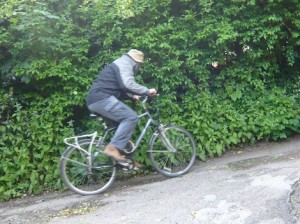 This is the ninth report on the author’s progress in his bid to cycle from Guildford to Edinburgh. The reports follow: Uphill All The Way – The Idea and Uphill All The Way – The Plan (Part One) and Uphill All The Way – The Plan (Part Two)
This is the ninth report on the author’s progress in his bid to cycle from Guildford to Edinburgh. The reports follow: Uphill All The Way – The Idea and Uphill All The Way – The Plan (Part One) and Uphill All The Way – The Plan (Part Two)
All Uphill All The Way articles can be found under the Leisure section heading on the front page, in their own sub-section called Uphill All The Way.
By Martin Giles
Everyone who likes to learn about English history or appreciates old English architecture should visit Lincoln.
The old city on top of the commanding hill is beautiful, interesting and memorable, especially because of the climb up Steep Hill (it is what it says on the tin) to reach it.
Having spent a morning writing my report of my journey to Lincoln I cycled the depressing mile, a road lined with fast food shops, from my truly magnificent B&B to the other side of the tracks. A railway line crosses a main road into the town, an unusual sight these days on a busy road.
I grabbed a salad meal at M&S for a late lunch, made my way up the hill to the square between the cathedral and the castle, found a bench and tucked in.
I was on a site probably first fortified in the Iron Age and certainly by the Romans who then populated the area with retired soldiers. It lay on the junction of two Roman roads, Ermine Street (the Roman M1) that ran from London northwards and the Fosse Way, the other end of which was in Exeter.
I wanted to learn more about the cathedral and decided to see if I could join a tour. The ‘high tour’ which takes visitors to roof top levels within the cathedral had been especially recommended in a guide book but the last one had been at 2pm, so with some resignation I joined a regular, ground level affair, at 3pm.
It was a good decision. There were just three of us plus the guide, who it transpired was a retired teacher who hailed from Farnham. The other two tourists were from Kent so we were a South East group.
The guide was excellent, very knowledgeable, of course, but with a gentle style of delivery and some good use of visual aids to assist explanation, especially of the incremental development of the building. He also encouraged questions and discussions, admitting that he preferred small groups for that reason.
So intrigued did we all become that the tour, which normally takes an hour ran on, with our agreement and encouragement, for nearly two. None of us minded.
I cannot, of course, relate everything he told us here but the story of Hugh of Lincoln stood out for me. Henry II, the king that had had Thomas Becket bumped off, recruited an unwilling monk from the south west of England for the job of Bishop of Lincoln.
It was an important role as the diocese, important economically for its wool production, stretched right down to the Thames by Oxford.
Despite a certain kleptomania when it came to holy relics, Hugh, by all accounts, was a good egg. Lincoln Cathedral had been badly damaged by an earthquake in 1185, and Bishop Hugh set about rebuilding and greatly enlarging it in the new Gothic style.
One story gives evidence of his humility. Hugh, having accepted that as the person responsible for much development of the cathedral, his likeness should be placed on one of two pinnacles over the front of the cathedral the carved likeness of a swineherd from nearby Stow who had contributed his meagre life savings be placed on the other, at equal height and prominence, to show that, whether a bishop or a swineherd, all are equal before God.
By the time the tour finished it was 5pm. All I had time left to do before things closed was have a quick look inside the castle but there is major renovation work under way and much was off limits to the public. I was though able to appreciate its dominating position and look out in the direction of my 42-mile route to Thorne, with relief noting that it appeared to be pretty flat.
I decided on an early dinner and back to the B&B for some rest before tomorrow’s efforts.
My fellow breakfast diner at Newark had advised me to go to Brown’s pie shop. I need little persuading when it comes to pies and I had noticed that it was just a few yards down the hill. A plaque outside explained that this had been Lawrence of Arabia’s billet when he had served as an airman nearby. It was where he wrote the Seven Pillars of Wisdom.
They were advertising for early diners a three-course deal for £12.95. It sounded good. I had. seafood salad, pie of the day (pork in cider) and veg, chocolate fudge cake and ice cream. Just right for the diet.
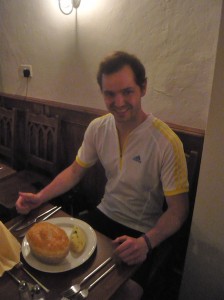
Jimmy the charity cyclist, whose five day ride from Leeds to Paris showed the sedentary pace of my tour.
Whilst I was there a young chap came in and said: “Can you bring me two pints of water please?” He made it sound urgent, “I have just cycled up Steep Hill.”
I was intrigued and introduced myself as a fellow cyclist. The waitresses hung around to listen or worry that the restaurant was fast becoming a cycle club.
It emerged that he was on a charity cycle ride to raise money for a charity that dealt with brain-damaged patients. He had become involved following the sad death of his brother. He was cycling from Leeds to Paris in just five legs and he still had to reach Boston that night.
I told him of my pathetic schedule but for him, at that moment, with legs of around 100 miles to complete, I think he was quite attracted to my plan. He might have readily swapped but there was no chance of that. I made a small donation and took this photo. His name was Jimmy. Good luck to him.
I walked back down the hill, remounted my bike pleased that my journey to my night time rest was just the mile back to Creston Villa, a gem of a find that fully deserves its five-star rating.
On my return I decided to tackle my front tyre which had been suffering from a slow puncture since day two. Two recently arrived guests, Siemens engineers from China, decided to help. I was happy to let them, especially as one of the wheel nuts proved a brute to get off.
Next day, I was up early and even felt enthusiastic. This was the second and final long legs of over 40 miles, but having checked the cross section there would be no gradient challenges. Steep Hill was not on my route.
However, the weather forecast indicated that I would be lucky to remain dry. I wondered whether Lear’s ‘wanton boys’ had forgotten me since their Grand Old Duke of York game, south of Melton. “Let’s put him up and down a few hills for a laugh.” I hoped they had or I could be in for another soaking.
When it came to leaving I did so regretfully. Carlton Villa, under the friendliest and most helpful of hosts, Iain and Anna, had been a great place to stay and the old city had surpassed my expectations. I want to return, explore further and see the castle when the refurbishment is complete and visit the Museum of Lincolnshire Life where one of the exhibits of of a World War I tank. They were produced with great secrecy here under the cover of being water ‘tanks’ for Mesopotamia.
Navigating out of Lincoln proved quite easy and for once there was no climb to higher ground. My route took me past the old port of Lincoln which operated up until the 1950s. There is quite a large industrial area around the southern side of the town which it must have served as well as the city. In addition to the port, according to my host, the city had also lost its direct line to London although there is now talk of it being reinstated.
I was soon on the towpath of the Foss navigation. The sky was grey but remained non-threatening and it was warm enough to cycle in just a shirt. I came across a walker who was observing the opposite bank with binoculars.
“What have you spotted?” I enquired. “A reed warbler,” he replied. Sadly it had flown off so I was unable to make it a personal sighting, a shame as I have never seen one before.
My journey after the towpath was mainly on minor roads. It remained flat but, probably because of the overcast sky, uninspiring, although a swan’s nest complete with cygnets was an attractive sight.
I had identified the town of Gainsborough as my stopping loin for lunch. It was about half way to Thorne my destination. Once again I had decided on a picnic, despite the weather. All I needed to do was to add to what I had with a tomato and some fruit.
With its name, Gainsborough implies an artistic appearance. Perhaps it would me surrounded with landscapes worthy of the great artist and populated with folk suitable for fine portraits? Of course I knew it was going to disappoint and it did. It is a town that has seen better days. Many of its population looked relatively poor, many dressed in tracksuit bottoms and tattoos.
I remain mystified about the attraction of tattoos. How much do they cost? Couldn’t they forego just one each for some proper trousers instead of tracksuit bottoms? If you totalled the amount spent on tattoos across the whole country and gave it to the exchequer it might make a significant dent in our burgeoning national debt.
But there was a lively market and I bought some delicious, small vine tomatoes and a few small apricots, equally good. I sat in a very small green. It was not ideal, but it would suffice. As I came to the end of my meal the rain started. I hurriedly packed up and pushed my bike to find some shelter hoping it was a shower. I sheltered under the canopy of a jeweller’s shop.
A lad came by pushing a pram, he told his young child that he would really like a £300 watch in the window. It made me sad. He was in his early twenties and I suspect was unemployed. His aspirations should have been more than to obtain something so material and unnecessarily expensive.
After 15 minutes the rain stopped and I was back on the road. The route was a path right beside a busy A road that turned into a dual carriageway. Although the path was separate it was a thoroughly unpleasant few miles.
A few miles further on and I was in an area of fenland the Isle of Axholme, which lie only a few feet above sea level. It was perfectly flat arable land, mainly wheat and sugar beet, and I could see for miles in every direction. Apart from drivers in the occasional vehicle, I seemed to be the only person around. The roads were wet and had numerous puddles I had obviously been preceded by a heavy shower. Some luck at last.
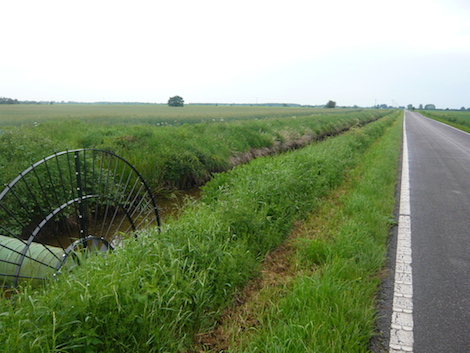
Deep ditches surrounded the fields in the fens of the Isle of Axholme, created from marshland by a Dutchman.
I read later that a Dutchman, Cornelius Vermuyden, had been responsible for transforming thousands of acres of marshland into valuable farmland. That it is still being used this way today indicates he did a good job. Wikipedia states: “The land is particularly fertile due to its history of annual flooding from the Trent and peat soil which was created by dense ancient woodland which covered much of the Isle.”
The town of Thorne likes to hide its existence, at least to those few travellers who travel across the fens from the south east. The first road sign I came across said Thorne 1¼ miles. I could have done with some navigational reassurance before that.
The less said about my accommodation in Thorne the better. At £49 per night it was no cheaper than average but it was poor. It was a manned by a solitary woman (who owned the place with her husband it transpired) who told me, as if it were a surprise, that there would be another guest that evening. I never did see her. Perhaps she quit while she was ahead. But I was too tired to argue and at least the shower had hot water and the bed seemed clean.
I ventured out for something to eat. The High Street appeared boarded up, I assumed to prevent damage from night time vandalism. It was a depressing sight. I found a pub that seemed busy. But the barman explained that they didn’t do food, apart from crisps. I had guessed that his mouth seemed to be full of them.
The barman did recommend another pub that had more than fried slices of potato on the menu. I found it. It was one of those places you can find nationwide. A large pub laid out as a restaurant. It was not ideal but it would do. I wondered how much their rooms were.
03.06.14 UATW computer data:
Miles cycled: 44.61 miles (longest leg)
Average speed: 10.2mph
Cycling time: 4 hours 20 minutes.
Next report: A technology disaster on a wet ride to York.



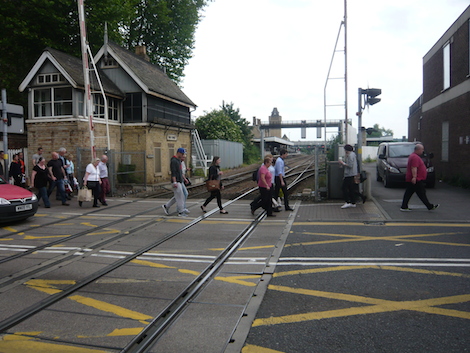
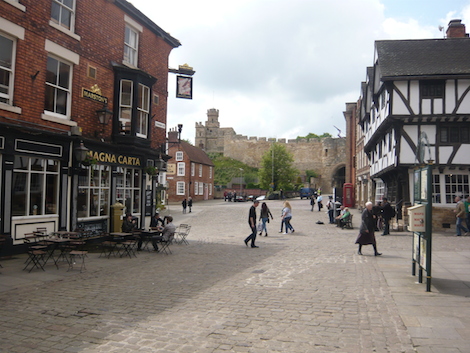
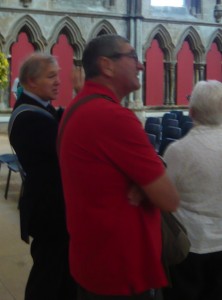



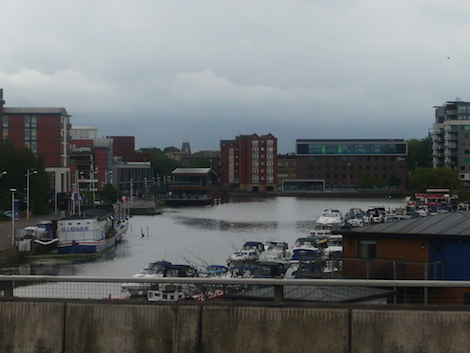
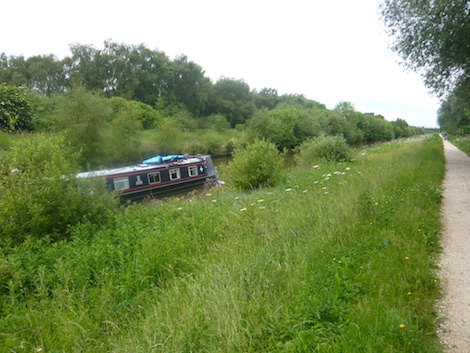

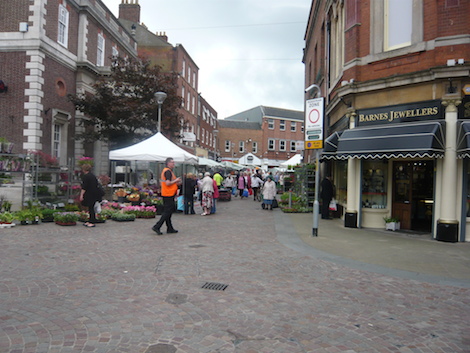
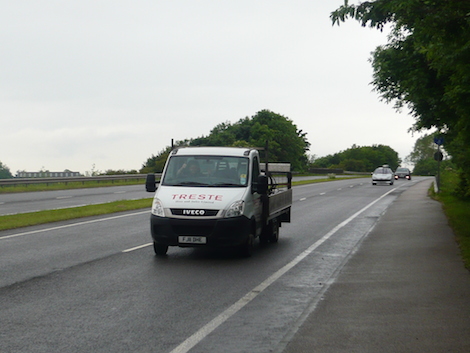
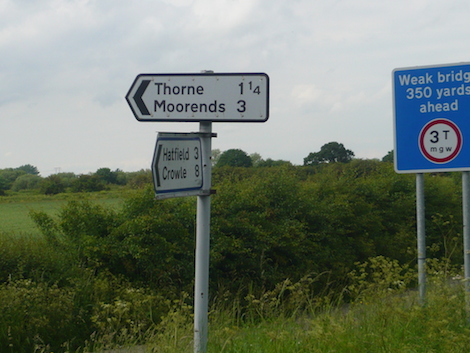
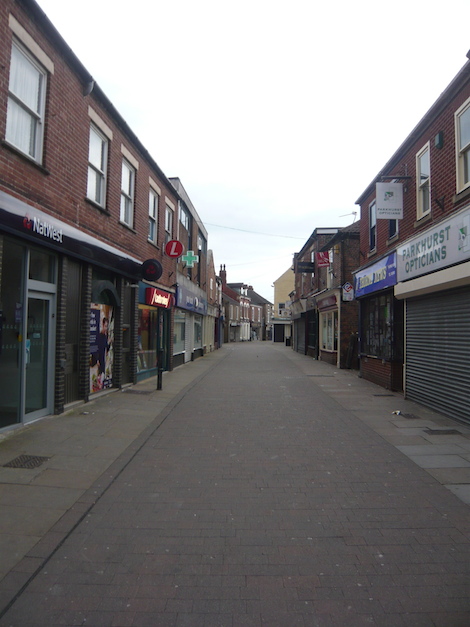









Recent Comments